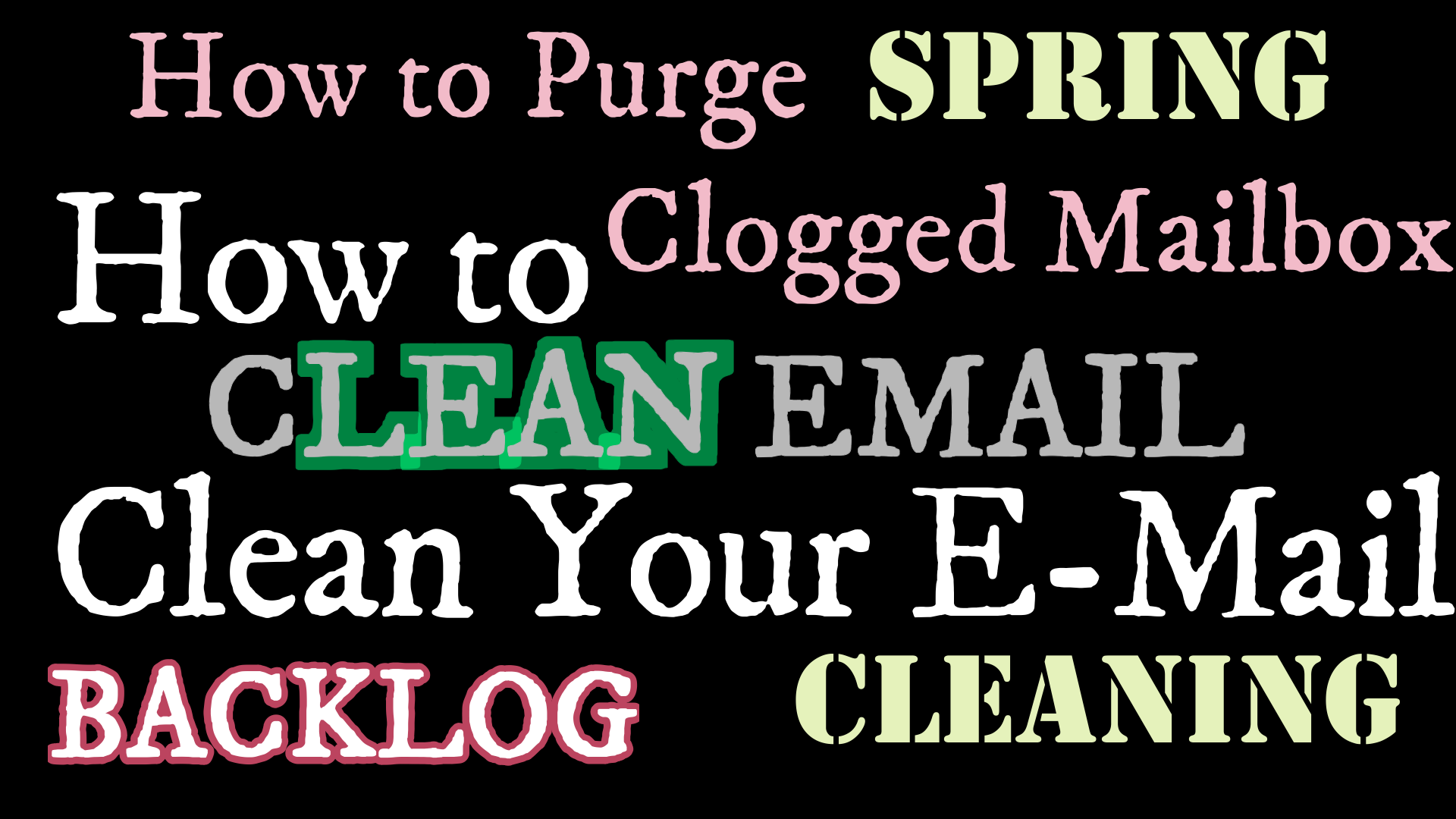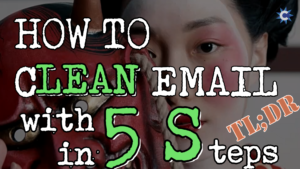Lean Email with 5S

How many unread emails are in your mailbox now? Dozens? Hundreds?
A year ago, one executive complained to me that he had over 3000 emails in his inbox, most of them unread. Six months later, he updated the figure to 5000, i.e. his unread backlog is growing slowly but surely, and so does his frustration.
Mind you, an overflowing inbox is also a major psychological risk. When you can’t handle the flow, the added stress contributes to potential burnout or depression.

If that sounds familiar, I have some good news for you: You can easily clear your mailbox literally within minutes – once and for all! If calling it LEAN MAIL makes you feel better, let’s use the Lean 5S methodology as a guide. Effectively, those are just common-sense steps that allowed me to go from 2385 unread emails to 699 in less than five minutes, thus already making the backlog altogether manageable. And if you are serious about performance, a couple more smart moves, plus sharing the best practices with your team – will change your relationship with email forever.
So if you are constantly overwhelmed with the information flow, here are the 5 steps that will help you out.
1. SORT
In most cases, emails in the Inbox are already sorted by RECEIVED date and time. Try sorting them by FROM, then sweep through the emails arranged that way. You will realize that some of the senders may have already left the company, while many others have never written anything meaningful. Delete their messages.
Next, rearrange your inbox emails by SUBJECT – and repeat the exercise. Get rid of multiple all-staff meetings, congratulations from the Corporate, mandatory trainings, and the like – what’s the point of keeping them?
Spam and other inappropriate messages often become more visible when sorted differently. Delete, delete, delete.
This sorting and removing the obvious made my mailbox shrink by 8% (from 2385 to 2216 unread). Often this step comes as a revelation – and the first sign of relief: you never expected that close to one-tenth of pending emails would be useless.
2. SET in ORDER
The second step, or the 2nd S in Lean 5S, is SET in Order.
For starters, focus on the emails that are addressed to you. If someone needs something specific from you, then they must put your name in the “To…” field. Otherwise, they are not serious.
To locate serious senders, filter out all emails that do not contain your name in the “To…” field and move them to some other folder, out of the Inbox. To automate the process, you need to create a Rule. This is a simple procedure but it helps a lot when you know how to apply it.
I was using MS Outlook for this account but other email applications have similar functionality. Go to HomeàRulesàAdvanced Options – there are a lot of premixed Rules here, including “where my name is in the Cc box” – but select “where my name is not in the To box” because there’s a lot of homegrown junk that goes out to “all,” with no names mentioned. Those emails would continue contaminating your inbox unless you protect yourself. Now you have instructed Outlook to move such messages to a specified folder – and that’s the new “CC” folder that you create while setting up the Rule.
Run this Rule right away. The first time, it may easily take a minute or more, so let’s fast-forward it, but in reality, it is worth the effort. In my test account, the backlog dropped to 699 unread messages (down from 2216 after Step 1). Not bad, eh?
If you follow these steps, you’ll notice that your Inbox has already become about two-thirds lighter. It may be crowded still – but not depressing, not like when we started the cleaning. And we are not done yet!
3. SHINE
Let’s dust-up our already tidied-up Inbox. The SHINE step comes after you have set your Inbox in order, and now want the new incoming messages to follow this new order.
Depending on the nature of your work and the sources of your correspondence, you may decide to set up some more filters effectively removing all unnecessary information from your view – and SHINE the mailbox further.
You may hesitate using filters and rules because moving an email from your boss out of sight could be a career-limiting move, even if your name is not included anywhere… But don’t worry, you can add an exception to the CC filter: “except the message is from [YOUR BOSS]” – and that extremely valuable message from your boss will never be ignored.
Note that many mailers are set up by the administrators in such a way that all messages from the top will end up in your main Inbox. So, your career is not at risk, relax.
And click “Apply.”
By the way, nothing has been deleted so far. In the unlikely event that you do need some of the filtered-out emails, you can easily retrieve them by looking for them in the CC folder or by simply searching for the keywords.
4. STANDARDIZE
When everything is sorted out and shined, you should automate the SHINE step, so that your INBOX remains in perfect order – and we stay relaxed, effective and efficient.
Probably, we could now process the remaining unread emails “by hand” – but do we have to do it the old way? And then again, if we do not implement certain standard procedures, the problem of the congested inbox will return. So let’s set up processes that will help eliminate the congestion.
The most common standard process is archiving the emails that have been sitting around for too long. Let’s be realistic: all emails have a limited shelf life. Some emails that are still in your Inbox are over a year old, and most probably expired. Get rid of them. Make it a standard procedure, and automate it as well.
“But what if there’s something important in those emails?” asks a scared career manager.
Humans are very loss-averse and tend to exaggerate the practically non-existent risks. This psychological phenomenon is beyond the scope of this video. In short, your chance to lose some critical piece of information is much less than getting clinically depressed while watching the backlog grow.
It is your call, but I suggest removing all mail that is older than 6 months, and, perhaps even less, setting up your email appropriately. It is safe to assume that what has not killed you within the set delay may be safely archived. Make it part of your standard procedure.
Of course, this standard procedure will become truly efficient only when you convince your team to adopt it as well.
And this brings us to the last and most challenging step:
5. SUSTAIN
By now you must have reached a manageable volume of unread mail and are ready to declare victory. The final S is about making this victory unconditional. Step 5 goes hand in hand with Step 4 = Standardize and maybe the most important part of the entire 5S process: ensuring Sustainability.
To paraphrase a famous quote (sorry, Mr. Chekhov),
“Clean is not where they pick up garbage, but where they do not crap.”
Thus, you will sustainably improve your mailbox’s health only if your colleagues are on board. This is culture change, and to sustain the new email culture, you must solemnly commit yourself to the following rules:
- Never “Reply to all,” period.
Remember how many emails you had to move to the CC folder? Most of them were generated by the “Reply All” button. - Always indicate a clear subject and only one subject per email. If you are bursting with information, write another email, with another subject, and update the “To…” field.
- Never “reply to” or “forward” an unrelated email “to save time” because you will make others waste 10x more time struggling to extract your message, including some people who should not be receiving this email.
- Unless your job is to analyze new trends in spam emails, never subscribe to anything, and cancel all existing subscriptions. Set up a separate private email if you want to get to multiple sucker lists.
- Bonus point: whenever this makes sense, set expiration dates on your emails. Not many busy leaders do this – only the best do.
 These 5S rules (in addition to other email rules) will help you to “lean up” your inbox, but making them sustainable is the hardest and most important part. Share these rules with the team (or come back soon for a video TL;DR version).
These 5S rules (in addition to other email rules) will help you to “lean up” your inbox, but making them sustainable is the hardest and most important part. Share these rules with the team (or come back soon for a video TL;DR version).
If, on the contrary, you think that “leaning” your email is a harmful exercise that can free up too much time, check out our concise email dumbing video “How to Write Useless Emails.”
